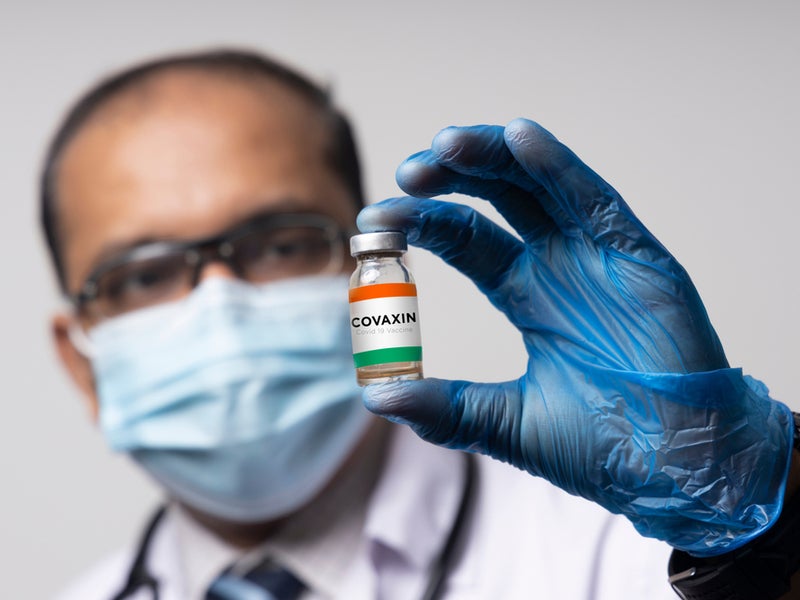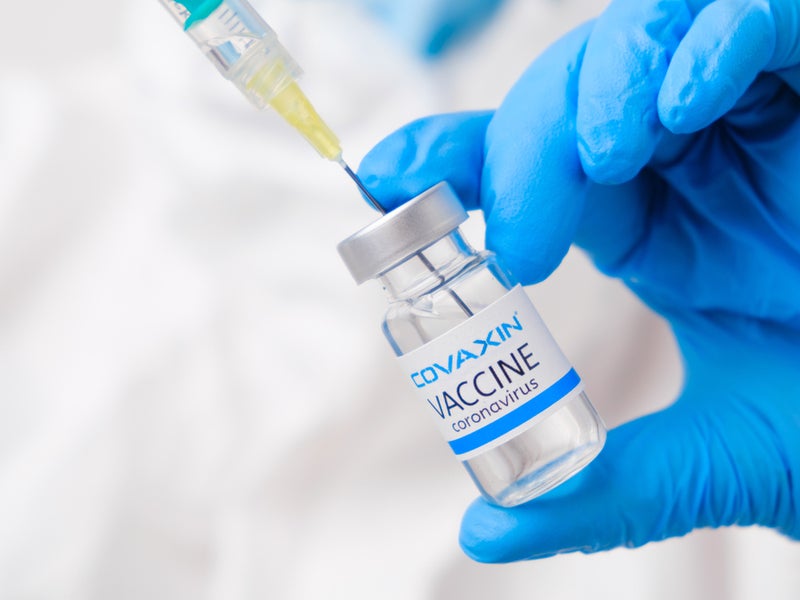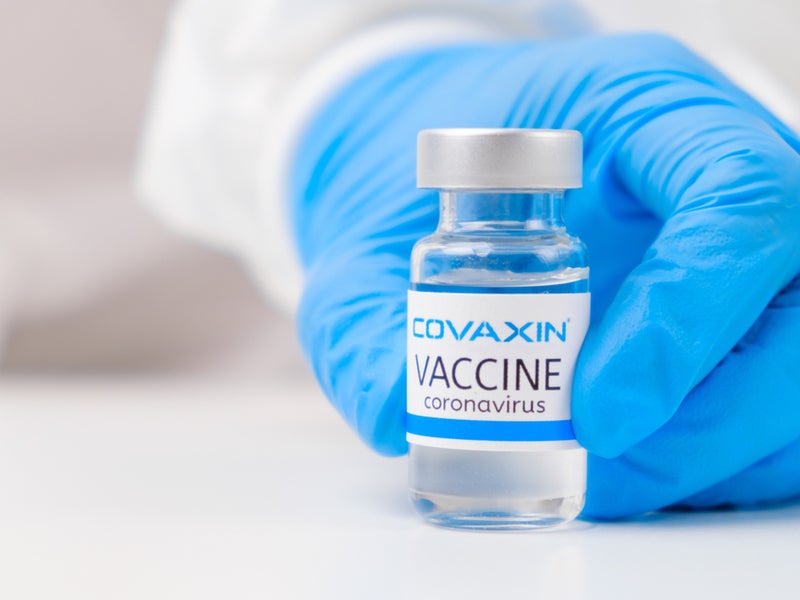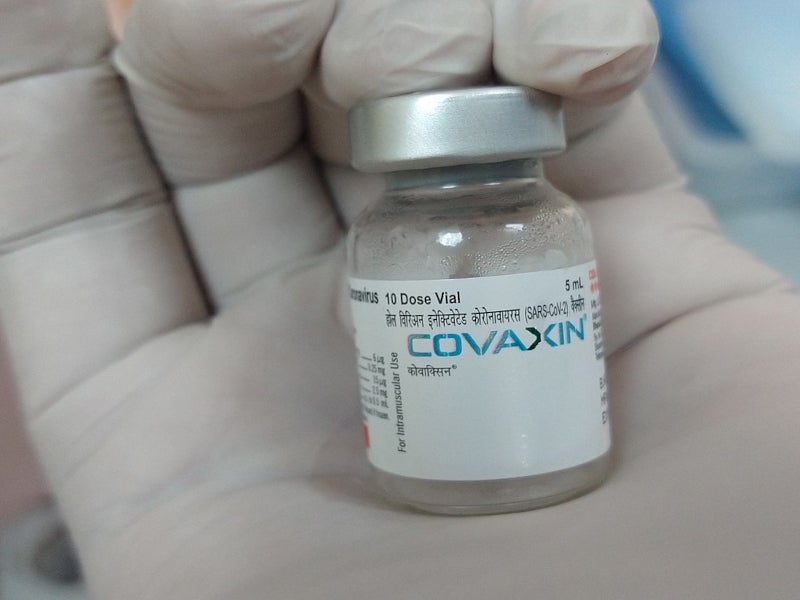Developed by Bharat Biotech in collaboration with the Indian Medical Research Council (ICMR) and National Institute of Virology (NIV), COVAXIN™ (BBV152) is India’s first indigenous, whole-virion, inactivated vaccine for the treatment of the highly infectious disease Covid-19.
The vaccine is derived from the Vero cell platform and manufactured at Bharat Biotech’s Bio-Safety Level-3 (BSL-3) high containment facility, which is located in Genome Valley, Hyderabad, India.
The vaccine is injected directly into the deltoid muscle, which is accessible in the upper arm.
In May 2022, the Coalition for Epidemic Preparedness Innovations (CEPI) partnered with an international multidisciplinary consortium, comprising Bharat Biotech International (BBIL), India; the University of Sydney, Australia; and ExcellGene, Switzerland, to provide funding of up to $19.3m for the development of a variant-proof SARS-CoV-2 vaccine candidate.
COVAXIN approvals
The National Regulator, Drugs Controller General of India (DCGI) granted conditional market authorisation for COVAXIN in January 2022. The approval came after the Subject Expert Committee (SEC) of the Central Drugs Standard Control Organization (CDSCO) recommended that the vaccine be upgraded from the authorisation of restricted use in emergency situations, which was granted in January 2021.
The CDSCO also approved the sale or distribution of COVAXIN for restricted use in emergencies of public concern.
COVAXIN received emergency use approval from the World Health Organization (WHO) in November 2021.
The WHO suspended the vaccine’s supply through UN procurement agencies following concerns over deficiencies in implementing good manufacturing practices (GMP) in April 2022. Bharat Biotech suspended the production of COVAXIN for export in response to this action and stated that it would address the deficiencies.
In December 2020, US-based biopharmaceutical company Ocugen signed a binding letter of intent (LoI) with Bharat Biotech to collaborate on the clinical development, registration and commercialisation of COVAXIN for the US market. According to the LoI, Ocugen will hold the US rights to the vaccine candidate.
In February 2022, the US Food and Drug Administration (FDA) lifted the clinical hold that it placed in November 2021 on the submission of its investigational new drug (IND) application to evaluate COVAXIN outside the US. The lifting cleared the path for Phase II/III clinical trials of the vaccine in support of a biologics license application (BLA) submission.
The FDA declined to issue an emergency use authorization (EUA) for COVAXIN for paediatric patients aged from two to 18 years in March 2022. In April 2022, Ocugen amended its agreement with Bharat Biotech to expand the former’s commercialisation rights of COVAXIN to include Mexico. Ocugen now holds the commercialisation rights for COVAXIN for all of North America.
COVAXIN has EUA for adults in Mexico and is approved for emergency use in 20 other countries. Applications for emergency use are also pending approval in more than 60 other countries.
COVAXIN is licensed for use in 23 countries worldwide, although its distribution is currently mostly limited to India, where more than 77 million doses have been administered as of June 2022.
Covid-19 causes and symptoms
Covid-19 (Coronavirus disease 2019) is caused by a new coronavirus, known as severe acute respiratory syndrome coronavirus 2 (SARS-CoV-2). Coronaviruses are enveloped positive-sense RNA viruses containing very large genomes of all RNA viruses, usually 27kb to 32kb.
The virus has a distinctive fringe of large, distinctive, petal-shaped and crown-like spikes.
Virus transmission occurs mainly person-to-person through close contact. It can impact the upper respiratory tract (sinuses, nose and throat) or lower respiratory tract (windpipe and lungs). The severity of infection can vary from very mild to severe.
Individuals with Covid-19 may experience a variety of mild or severe symptoms, which can develop between two and 14 days after exposure to the virus. The period between virus exposure and symptom onset is known as the incubation phase.
Common symptoms of the condition include cough, fever or chills, shortness of breath, tiredness, nasal congestion, headache, conjunctivitis, muscle or body pain, sore throat, loss of taste or smell, diarrhoea, and nausea or vomiting in people of all age groups.
COVAXIN mechanism of action
COVAXIN is an inactivated vaccine obtained from the SARS-CoV-2 strain, which was isolated at the NIV, an Indian virology research institute located in Pune. The vaccine works by stimulating the immune system to produce antibodies against the inactivated SARS-CoV-2 strain.
The vaccine is used, along with immune stimulants commonly known as vaccine adjuvants (Alhydroxiquim-II), to improve the immune response and provide longer-lasting immunity. The vaccine candidate is produced through the formulation of the inactivated virus with Kansas-based ViroVax’s Alhydroxiquim-II adjuvant.
COVAXIN contains 6µg of whole-virion inactivated SARS-CoV-2 antigen (Strain: NIV-2020-770). Other inactive components include 250µg aluminium hydroxide gel, 15µg TLR 7 / 8 agonist (imidazoquinolinone), 2.5mg TM 2-phenoxyethanol and up to 0.5ml of phosphate buffer saline.
The vaccine does not require sub-zero storage or reconstitution and is available for use in multi-dose vials, which are stable at 2℃ to 8℃.
Clinical trials for COVAXIN
In June 2020, the DCGI-CDSCO Ministry of Health and Family Welfare issued permission to begin Phase I and Phase II human clinical trials for COVAXIN, following the demonstration of safety and immune response in preclinical studies.
Preclinical research showed high immunogenicity and protective efficacy in animal challenge studies undertaken in hamsters and non-human primates.
A total of 375 patients were recruited in the Phase I trial and established excellent safety data without any reactogenicity. Vaccine-induced neutralising antibody titers of two divergent SARS-CoV-2 strains were also observed. The percentage of all side effects combined among vaccine patients was just 15%.
In the Phase II study, 380 patients aged between 12 and 65 years were enrolled. COVAXIN contributed to tolerable safety results and improved humoral and cell-mediated immune responses.
The Phase III trial, which began in mid-November 2020, is India’s first, as well as the largest, Phase III efficacy trial to be conducted for Covid-19.
The multi-centre, double-blind study enrolled 27,000 participants across India. The participants received two intramuscular injections within 28 days.
The first vaccination dose was given to all participants. The second administered dose was either vaccine or placebo.
Efficacy was determined by the occurrence of Covid-19 cases between the vaccine and placebo arm, which started two weeks after the second dose. The final efficacy analysis from the Phase III trial was released in July 2021. The analysis indicated an overall efficacy of 77.8% against symptomatic Covid-19.
In January 2022, Bharat Biotech reported positive results from a Phase II study of COVAXIN in patients aged between 12 and 64 years who received a booster dosage six months after a second dose.
The results indicated that more than 75% of patients demonstrated a detectable neutralising antibody response six months after their second COVAXIN dose.
Participants showed an increase in antibody titers on day 28 after receiving the booster dose. The neutralising titers were found to be higher than those achieved after the two-dose regime.
Furthermore, participants did not show any adverse effects following the administration of the booster dose.
A laboratory analysis sponsored by Ocugen and conducted at the Emory Vaccine Center in Atlanta, Georgia, US, in January 2022, confirmed that the COVAXIN booster dose demonstrated robust neutralising antibody responses against the Omicron (B.1.529) and Delta (B.1.617.2) variants of the virus. The analysis studied sera samples collected from individuals who had received a booster of COVAXIN.
More than 90% of patients who took the booster dose developed neutralising antibodies.
Side effects observed with COVAXIN include pain, swelling, redness and itching at the injection site, as well as body ache, weakness, stiffness, nausea, vomiting, fever, malaise and headache.
COVAXIN also demonstrated promising safety, efficacy and superior response in paediatric patients compared to adults in a Phase II/III clinical study that enrolled 526 children.











